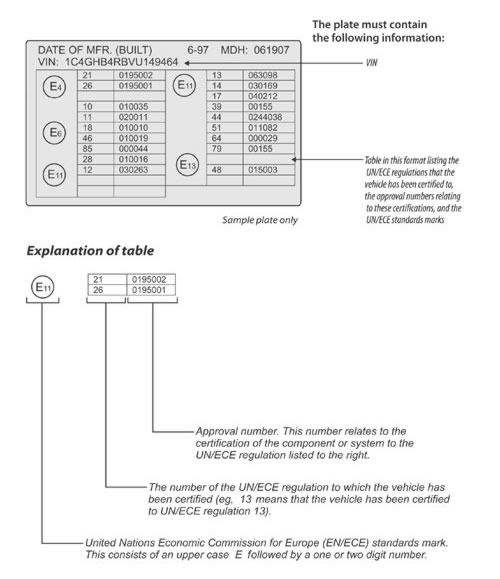If you're importing a used vehicle from Europe (including the United Kingdom) you must provide evidence that it meets a range of approved standards before it can be registered for use on the road.
Europe has two vehicle standards regimes:
Evidence that your vehicle complies with either of the standards may be acceptable for New Zealand requirements.
You must provide evidence of:
You need to provide evidence that you're the legal owner of the vehicle. This includes:
For both used and parallel-imported new vehicles, acceptable proof your vehicle meets New Zealand requirements can be:
The following is a list of EC/EEC directives for vehicle exhaust emissions and the 'Euro' emissions level corresponding to each directive.
| 70/220/EEC | Euro 0 unless accompanied by one of the appropriate directives for Euro 1, Euro 2, Euro 3 or Euro 4. |
| 91/441/EEC | Euro 1 |
| 93/59/EEC | |
| 94/12/EC | Euro 2 |
| 96/44/EC | |
| 96/69/EC | |
| 98/69A/EC | Euro 3 |
| 98/77A/EC | |
| 1999/102A/EC | |
| 2001/1A/EC | |
| 2001/100A/EC | |
| 2002/80A/EC | |
| 2003/76A/EC | |
| 2006/96A/EC | |
| 98/69/EC | Indeterminate – the default emissions level is Euro 3 unless otherwise indicated on compliance documentation |
| 98/77/EC | |
| 1999/102/EC | |
| 2001/1/EC | |
| 2001/100/EC | |
| 2002/80/EC | |
| 2003/76/EC | |
| 2006/96/EC | |
| 98/69B/EC | Euro 4 |
| 98/77B/EC | |
| 1999/102B/EC | |
| 2001/1B/EC | |
| 2001/100B/EC | |
| 2002/80B/EC | |
| 2003/76B/EC | |
| 2006/96B/EC |
If a directive is not listed on the above table, and the first number is a '7' or an '8,' the emissions level is Euro 0.
The following is a list of UN/ECE regulations for vehicle exhaust emissions and the 'Euro' emissions level corresponding to each regulation.
| UN/ECE Regulation 83.02 | Euro 1 |
| UN/ECE Regulation 83.03 | Euro 2 (passenger cars only); Euro 1 (light commercial vehicles only) |
| UN/ECE Regulation 83.04 | Euro 2 |
| UN/ECE Regulation 83.05 | Indeterminate – the default emissions level is Euro 3 unless otherwise indicated on compliance documentation |
The regulation name can be listed either independently or within a UN/ECE system approval number.
You may be able to prove your car complies using our frontal impact lists. These lists cover vehicles manufactured during 1994–1996 when frontal impact standards were being developed. They therefore apply mainly to used imports. If the list says your vehicle does not meet a frontal impact standard, then you cannot bring it into New Zealand.
Your vehicle isn't listed? Your vehicle will most likely have an EC whole vehicle approval plate/sticker affixed to it, which you may be able to use to show that it complies with almost all of New Zealand's vehicle requirements. You can only use it as evidence if it includes the EC directive '2001/116'.
You may not have to prove your vehicle complies with frontal impact standards if:
Find out more about these exceptions.
If your Class MB or Class MC vehicle was manufactured after 1 October 2003, it must meet a frontal impact standard. The exception is if you're emigrating to New Zealand and bringing your vehicle with you. Find out more about this exception.
Your vehicle will most likely have an EC whole vehicle approval plate or sticker attached to it, which you may be able to use to show that it complies with almost all of New Zealand's vehicle requirements. You can only use it as evidence if it includes the EC directive '2001/116'.
You can use our online tool(external link) to provide the fuel consumption compliance information. You'll then receive a fuel consumption certificate, which you take to the entry certifier.
All MA, MB, MC vehicles having UN / ECE compliance from 1 November 2014 have electronic stability control. Otherwise, you must check for the presence of ESC. See the technical bulletin about how to prove the existence of ESC in the electronic stability control identification bulletin(external link).
You must check for compliance with one of the approved brakes standards if you want to import a heavy vehicle of class MD3, MD4, ME, NB or NC, no matter what date the vehicle was manufactured.
See the detailed information about how to prove compliance with an approved brake standard in the following sections of the Vehicle inspection requirements manual – entry certification(external link):

Identifying the UN/ECE compliance plate - motorcycles.

Identifying the UN/ECE compliance plate - vehicles excluding motorcycles.
In many cases an EC whole vehicle approval plate/sticker or a suitable UN/ECE Approval plate/sticker affixed to your vehicle is acceptable evidence that your vehicle meets applicable standards in New Zealand. This proves your vehicle met the EC or UN/ECE standards when manufactured.
Talk to an entry certifier to check whether the EC or UN/ECE whole vehicle approval on your vehicle is acceptable.
No plate or sticker? You'll need to get a statement of compliance as evidence.